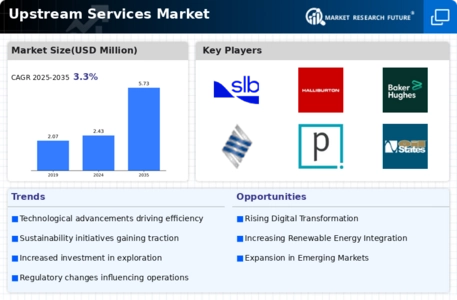Market Analysis
In-depth Analysis of Upstream Services Market Industry Landscape
The market dynamics of the Upstream Services industry are significantly affected by technological progress in exploration and production technologies. Continuous innovation in drilling techniques, geophysical survey methods, and reservoir management technologies lead to the emergence of more efficient and cost-effective upstream service. Research and development investments by service providers have led to advanced solutions that increase accuracy of resource assessment, improve drilling efficiency, and optimize reservoir performance. The successful integration of digitalization, data analytics, and automation further enhances the capabilities of upstream services making them an integral part of oil and gas projects’ success. The Upstream Services market is greatly shaped by geopolitical factors as well as regulatory frameworks. Geopolitical events, regulatory changes and government policies have high impact on oil & gas industry. Political stability, fiscal regime and regulatory clarity make some regions attractive for investment in upstream or not; thus influencing attractiveness for investment in upstream resources among various areas. That said favorable governmental regulation mechanisms combined with encouraging public policy stance has resulted into increased activities in exploration as well as production leading to a rise in demand for upstream services. Oil prices, gas prices ownership structure, overall economic condition etc., are the major economic parameters impacting on the Upstream Services market. Commodity price fluctuations affect the financial viability of these projects along with how much companies will be willing to invest into exploration or simply leave it alone. In a period when there is low demand flow for natural gases caused by economic recession may reduce this year’s budgetary allocation towards initial capital expenditures; however periods were there are high prices put pressure on exploration budgets. Environmental issues together with sustainability programs shape the market dynamics within Upstream Services. Environmental concerns have made people take a closer look at what oil &gas industry does hence pushing towards sustainable practices being implemented instead. To respond to this trend upstream firms offer technology or solutions that reduce their environmental footprints, lower emissions and in general increase the level of sustainability within their oil and gas operations. For instance, eco-friendly practices are accelerated by environmental regulations and corporate responsibility initiatives enacted across the upstream.










Leave a Comment